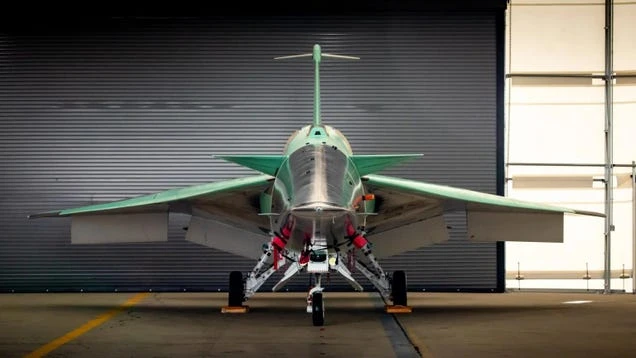We’ll Get to See nasa‘s Sonic Boom-Less Supersonic Plane Next Week
nasa’s supersonic experimental plane—the linchpin of the agency’s Quesst mission—is set to roll out of its warehouse in the California desert next week. We’re gassed for the big moment: the X-59 has been in development for six years, and, if successful, it will demonstrate supersonic flight without sonic booms.
The 99-foot-long (30-meter) plane is just 14 feet (4.27 meters) tall, making it look needle-like from the side.
The single-engine jet will have a cruise altitude of 55,000 feet (16,764 meters) and will be capable of speeds up to 925 mph (1,489 kmph), or Mach 1.4.
But here’s the kicker: The plane will only create a perceived sound of 75 PLdB, or about as loud as a car door closing.
Loud sonic booms occur when an object travels faster than the soundwaves it produces. While the booms cannot be heard by those aboard the speeding object—as they are traveling faster than sound—on the ground, the noise can startle people, panic animals, and generally be a nuisance for anyone within earshot.
Development Journey of x-59
Originally expected to make its first flight in 2023, the x-59 faced delays due to the need for additional time to integrate various systems and fix recurring computer issues.
The plane also underwent structural testing and ground tests to ensure its safety and functionality.
Although the X-59 research aircraft is a bright mint green, the aircraft to be revealed next week will be red, white, and blue. This color scheme not only reflects a patriotic aesthetic but also serves to protect the plane from moisture and corrosion.
The Significance of the x-59
The successful demonstration of supersonic flight without sonic booms by the X-59 has the potential to revolutionize the future of aviation.
The avoidance of loud sonic booms is a pivotal consideration in the development of supersonic travel, as it could enable commercial supersonic flight over land, which was previously restricted due to the disruptive nature of sonic booms.
With the X-59, nasa seeks to demonstrate supersonic flight with a muffled boom—a “sonic thump.”
Historical Context: The concorde
The discussion of supersonic aircraft cannot ignore the iconic concorde, a supersonic commercial jet that ceased operations in 2003.
Before its retirement, the concorde faced challenges due to the disruptive nature of its sonic booms, which restricted its ability to fly at supersonic speeds over land.
The limitations imposed by sonic booms led to increased costs and noise complaints, ultimately impacting the feasibility of commercial supersonic travel.
Phases of the x-59 Project
The upcoming first flight of the X-59 marks the beginning of its Phase 1, where its quiet supersonic technology and performance will be rigorously tested in the air.
Subsequently, in Phase 2, the aircraft’s actual supersonic presence will be evaluated, leading to Phase 3, where the x-59 will fly over various U.S. cities to assess the perception of its supersonic flight by residents.
This extensive evaluation, expected to run through 2027, will provide valuable data to regulators, potentially influencing the regulations surrounding commercial supersonic flight over land.
Implications for the Future of Supersonic travel
The successful implementation of the X-59’s technology could pave the way for substantial changes in the regulations governing supersonic flight over land.
By demonstrating the potential for low-impact supersonic flight, the Quesst mission led by the X-59 holds the promise of transforming the future of aviation.
As the journey towards the X-59’s first flight accelerates, the anticipation for a breakthrough in supersonic travel continues to build.
Source: gizmodotech








No Comments